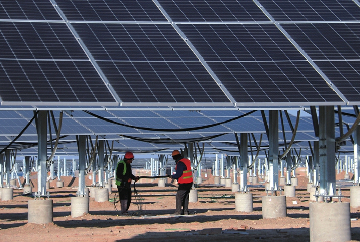-
Tel:+86 18948187408


cross border logisticsChina has progressed in transitioning toward a greener economy, influential voices in global energy field said on Tuesday during the ongoing World Economic Forum (WEF). And, energy supply issues serve as a wake-up call for all governments to ramp up new energy development and ensure energy security, experts said.
A reversal in reduced global carbon emissions since last year in the face of energy shortages points to a bumpy road ahead for the energy transition, they noted.
In remarks via video to the WEF panel discussion on China in the global energy transition, Zhang Zhigang, president of State Grid Corp of China, said that China has made significant achievements in its energy transition.
Non-fossil energy consumption as a share of the nation's total energy consumption rose from 12 percent to 16.5 percent from 2015 to 2021, and the installed capacity of renewable energy grew to 1,030 gigawatts, according to Zhang.
China has been focusing on wind and solar power over the past two years, with new installed capacity exceeding 100 gigawatts per year. The proportion of electricity in energy consumption increased from 21.4 percent to 28.2 percent over the six years ending 2021, he disclosed.
China has been ambitiously promoting the adoption and use of new-energy vehicles (NEVs) with sales reaching 3.5 million in 2021, Ni Jun, chief manufacturing officer of Contemporary Amperex Technology Co, the world's largest electric vehicle (EV) battery maker, said via video at the panel.
Zhang and Ni noted that Chinese enterprises are deploying various strategies to promote clean energy, while continuously working on innovative technologies to hasten the transition.
For example, SGCC has been implementing a digital transformation of the power grid with 8,000 smart substations and 500 million smart electricity meters, while more than 90 percent of the distribution network has been automated, meaning it is easily monitored and controlled, said Zhang.
Energy supply woes, resulting from the Russia-Ukraine conflict, have sounded an alarm about energy security for all countries, consequently fueling a push for renewables, Lin Boqiang, director of the China Center for Energy Economics Research at Xiamen University, told the Global Times on Tuesday.
Renewables are domestically based and not dependent on other countries, thereby freeing many economies including China from anxieties over a reliance on energy imports that have become increasingly insecure amid geopolitical tensions, Lin said.
New energy commitments that warrant energy security as well as a low-carbon growth path would be a prevailing trend, and China will add more wind and solar power, produce more EVs, and pursue hydrogen energy, carbon capture and storage, he said.
While China used to play catch-up with other economies on traditional energy, the renewables arena is a battlefield where no one has a real head start, according to Lin.
The expert said that China's leadership in clean energy investment would pave the way for a greater green footprint in the world. That would mean "intensified new energy competition between China and the US, but China is not afraid of contest as its renewable advantages far outstrip its competitiveness in traditional energy."

Along the country's road map for carbon peaking and neutrality, green finance is on the agenda to endorse environmentally friendly businesses, said Ma Jun, director of the Beijing-based Institute of Public and Environmental Affairs.
China's central bank, and its banking and insurance regulator, among other financial authorities, have moved to funnel more funding to green sector. The Institute of Public and Environmental Affairs has over the past two years assisted banks — including large state-owned lenders — to comb through the environmental performance of 300,000 businesses in the country.
The institute began tracking the environmental performance of domestic businesses in 2006 and has so far covered over 10 million firms, with its big data-powered dynamic environmental performance assessment offering ratings for tracked firms.
"China has made enormous progress in its environmental oversight and information disclosure," Ma said, speaking of the feat in enhancing environmental transparency.
However, as China is still highly dependent on coal-based power resources, which provide 60 percent of the country's energy, industry insiders noted that challenges remain for the transition, especially during the global energy crisis seen in October 2021.
Daniel Yergin, vice chairman of S&P Global, told the WEF panel that the energy transition is going to be more complicated — not just in China but also elsewhere. This raises the question of whether the transition is going to be a smooth one.
An increased focus on security spanning energy, food and supply chains has promoted major economies to ramp up fossil energy capacity since last year. As a consequence, global carbon emissions, which saw a marked decline in 2020, reversed course in 2021, Ma said.
This trend would continue in the foreseeable future, he said, calling for efforts to ensure energy security while curbing the expansion of energy-intensive, polluting industries. That's especially the case in China, where coal-fired power plants still play a significant part in ensuring domestic energy supplies.
At the enterprise level, Zhang said that achieving a green transformation requires the involvement of all parties including the government.